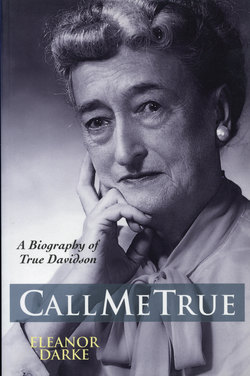Читать книгу Call Me True - Eleanor Darke - Страница 7
На сайте Литреса книга снята с продажи.
ОглавлениеINTRODUCTION
“Just call me True,” she’d say when being introduced. She didn’t like being called “Miss Davidson”; despised “Ms”; and, much as she gloried in her position as Mayor of East York, was politically astute enough to avoid the over-use of her title. Throughout her political career, she used the name “True” to define her character, policies and beliefs. But what can we “truly” say about True? In 1968, she told a reporter that “life in politics is like living in a goldfish bowl and the refractions mask what you really are. You have to let people think as they like and you go ahead and be as you are. If you have great luck and good friends you are successful. My life is an open book and sometimes I think it’s a cartoon.”1 Her opponents would laugh at the supposed passivity of this statement, arguing that True never missed an opportunity to use the media to present her own image of herself. If she was a goldfish, she was one with a doctorate in the control of refractions. She told the same stories of her life repeatedly, carefully revealing only what she wanted while ensuring that the reporter got enough material not to feel the need to dig for more. She was content to be painted as a cartoon. It was politically effective and ensured some personal privacy. Cartoons, after all, communicate their message simply and clearly and are more quickly understood than a fully detailed drawing.
True was a complex personality; frequently contradictory in her opinions; changing opinions (and her vote) repeatedly on many issues. She could be irascible, demanding, opinionated and caustic, yet she was often kindly and she was always dedicated and deeply devoted to the people of “her” municipality. I hope that the reader of this book will find in it a more fully-fleshed True than the cartoon she projected to the newspapers, although I doubt whether anyone could capture all of her variations.
As she told Star reporter, Brian Swarbrick, in 1971, “There are various aspects of truth. What seems true when reviewing one aspect may not necessarily be true when considering another ...”2
This book and my search for the “true True” would never have happened without help from a long list of people. I never would have begun it without the encouragement and support of John Ridout, Chair of the East York Historical Society and of my publisher, Barry Penhale, of Natural Heritage Books. True would have approved of John and Barry’s efforts; as she told the Barrie Kiwanis Club in 1928, “anyone who did anything to promote Canadian literature was doing a service to his country.”3
The staff at Victoria College and the Metropolitan Toronto Reference Library were very helpful. Special thanks are due to the staff of the Archives and Special Collections section of the York University Archives who helped me work through the large collection of True’s papers that were donated to them after her death. True was a pack-rat who didn’t believe in wasting paper, frequently reusing the back of older documents and writings. Their patience and encouragement as I tried to sort out what was written when was very helpful. Since I did the research for this book while holding a full-time job, I am particularly appreciative of their willingness to try and work around my days off.
The written sources gave me the majority of the dates and events of her life but only a small taste of her personality. Fortunately, no one who met True ever forgot her and one of the great privileges I have had while working on this project has been the pleasure of meeting and speaking with some of the extraordinary people whom she knew. In fact, one of the most difficult parts of researching this book was deciding to stop interviewing. Every person I spoke to suggested at least two more people to whom “I had to speak.” It was hard to declare a halt. Meeting such fascinating people enriched me as much as they did the book.
I am especially grateful to her nephews, David and Michael Cobden, for all of their help and advice. While the list of the others who shared their memories of her with me in interviews and letters is too long to provide here, I hope they will recognize their contributions in the text and accept my sincere appreciation for their help and honesty. If this book succeeds in any way to effectively convey a true picture of True, it will have been because of the memories and opinions that they so generously shared with me.
Eleanor Darke, 1997
